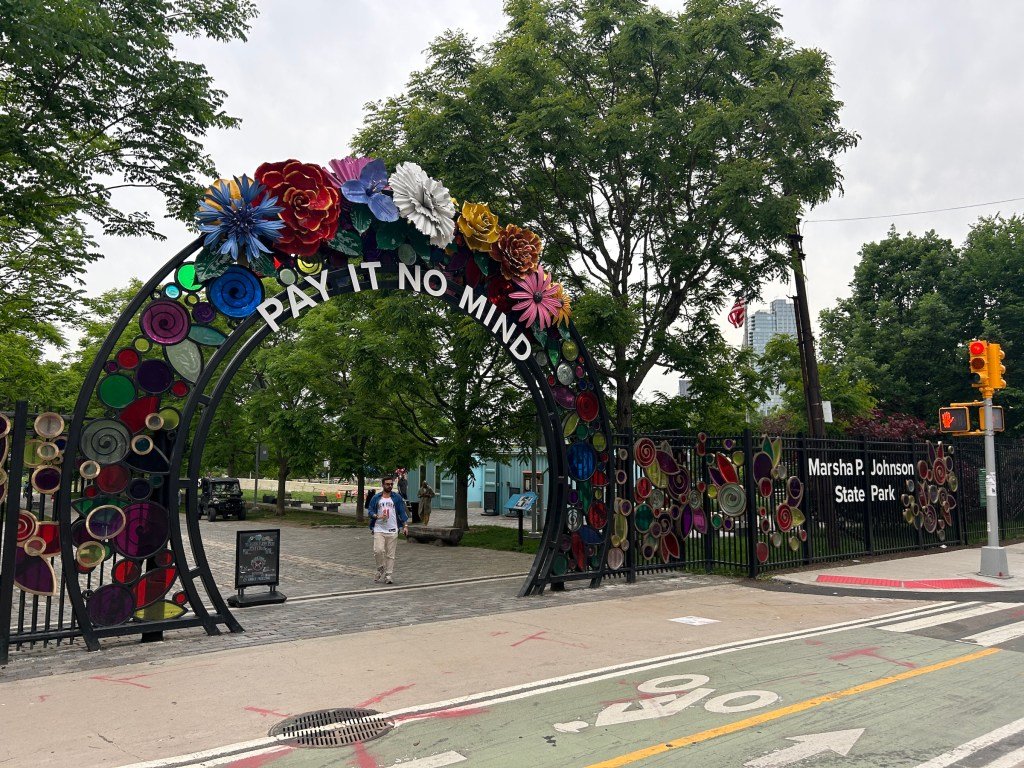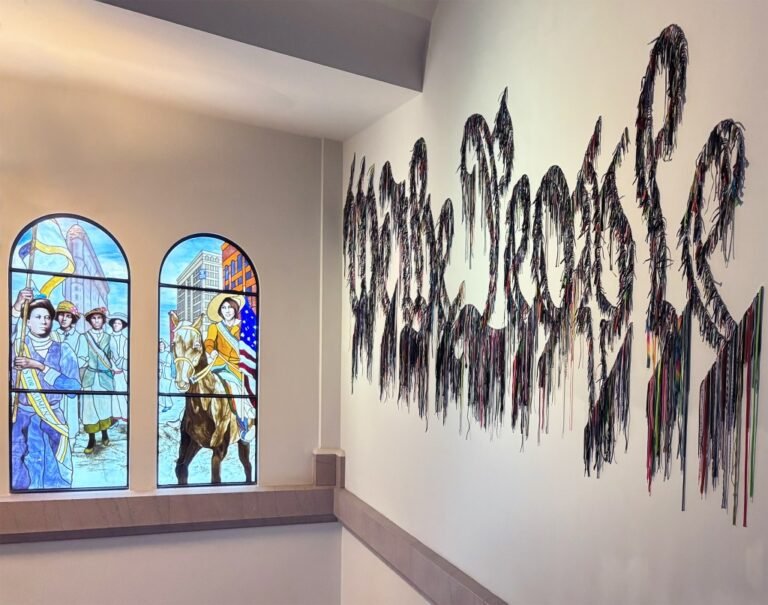

This article is part of Hyperallergic’s 2025 Pride Month series, spotlighting moments from New York’s LGBTQ+ art history throughout June.
Whether serving as sites of protest, celebration, communal mourning, or remembrance, public parks have always played a vital role in the history of New York City’s LGBTQ+ rights movement. Across the five boroughs, from the “People’s Beach” at Jacob Riis Park to the piers running along the Hudson River waterfront in Greenwich Village, these freely accessible outdoor locales have allowed historically oppressed queer groups to come together and express themselves without restriction or stigma. Park landmarks like Emma Stebbins’s Bethesda Fountain in Central Park pulse with their own LGBTQ+ history.
Before the 1969 Stonewall uprising, Christopher Park, the small triangular green space directly across from the famous inn on the corner of Seventh Avenue, was long a shelter for queer and gender non-conforming youths (many of whom were unhoused) escaping violence and abuse they experienced at home or on the streets. On the night police raided the Stonewall Inn, it became a refuge for protesters, who formed kick lines and sang humorous songs to taunt officers. And during the peak of the riots, the park was swarmed with several thousand people who had taken to the streets to confront police. In the aftermath, the park endured as a symbol of LGBTQ+ activism, hosting demonstrations led by newly formed groups like the Gay Activists Alliance and the Gay Liberation Front. It was also where LGBTQ+ rights advocate and Stonewall leader Marsha P. Johnson could often be found panhandling for funds that would usually be redistributed to those in need.

Later, queer rights and AIDS activist Bruce Voeller, who co-founded the National Gay Task Force (today known as the National LGBTQ Task Force), proposed the idea of placing a commemorative statue in the park on the 10th anniversary of the Stonewall rebellion. Louisiana arts patron Peter Putnam agreed to finance the project, and Pop Art sculptor George Segal was commissioned on the stipulation that the artwork “had to be loving and caring, and show the affection that is the hallmark of gay people … and it had to have equal representation of men and women.”
The resulting sculpture, “Gay Liberation” (1980), shares many characteristics of Segal’s figurative plaster sculptures. Four unidentified life-sized figures — a masculine couple standing and a feminine couple seated on a bench — are shown in relaxed poses. Although city officials announced the commission in July 1979, public opposition and a two-year renovation of the park would delay its unveiling until June 1992.

In 1999, Christopher Park was placed on the New York State Register of Historic Places along with other notable Stonewall sites, and was also added to the National Register.
Like much of LGBTQ+ history, the memorialization of Stonewall has frequently faced criticism for its whitewashing of the rebellion and its exclusion of the trans and gender non-conforming individuals who spearheaded the initial rebellion, including Johnson, Stormé DeLarverie, and Sylvia Rivera. The individuals in Segal’s sculpture, for instance, appear White and cisgender.
“It would be great to have a sculpture that was more representative of the diversity of the community, in particular, those who were really behind the Stonewall uprising, who were Black and Brown trans women and butch lesbians,” Cathy Renna, communication director at the National LGBTQ Task Force, told Hyperallergic.

New York City community members have tried to rectify the longstanding omission of trans individuals and people of color. Following decades of petitions demanding that public officials install a monument of Marsha P. Johnson in the West Village, former mayor Bill de Blasio announced in 2019 that the city would erect permanent monuments honoring her and Rivera. But these have yet to materialize.
“We had the full backing of the city, and then we got a new mayor, and it hasn’t happened. You do the math on that one,” Renna said.
In 2021, community activists took matters into their own hands and put up their own guerrilla bust honoring Johnson in the middle of Christopher Park. Created by artist Jesse Pallotta, “A Love Letter to Marsha” (2021) was later displayed at the Lesbian, Gay, Bisexual and Transgender Community Center.

City officials formally renamed Brooklyn’s seven-acre waterfront East River State Park after Johnson in 2020, making it the first state park in New York to be named after an LGBTQ+ person, according to the New York City LGBT Historic Sites Project. A floral gateway added in 2023 greets visitors with the words “Pay it no mind,” Johnson’s motto that the “P” in her name stood for, and her retort when faced with questions about her gender.
The erasure of trans community members and people of color from the memory of Stonewall remains an enduring threat, especially during the second term of Donald Trump’s presidency, which has been characterized by relentless attacks on trans and gender non-conforming people nationwide. Earlier this year, the National Park Service removed references to trans and queer people from its webpage describing the Stonewall riots. And last week, the Supreme Court ruled that public school systems are required to provide parents with the choice to “opt out” their children from course material that conflicts with their religious beliefs — namely, books with LGBTQ+ themes or characters.
“We’re seeing very active, very intentional erasure of queer history, whether it’s monuments, whether it’s in schools, whether it’s in government entities,” Renner said.
On Thursday, June 26, the National LGBTQ Task Force and the International Imperial Court Council added the names of seven trans and nonbinary activists to the Stonewall Inn’s Wall of Honor, which posthumously honors LGBTQ+ heroes from all sectors of art and activism.
“ We’re a resilient community. We’re certainly not giving up,” Renner said. “And I think that if you look at the results of the recent election in New York, maybe not too far in the future, we will have a candidate [Zohran Mamdani] who has promised millions of dollars for trans-affirming care, so asking for some historic recognition is gonna be a pretty low lift.”






